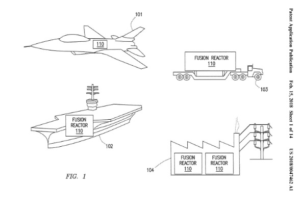Thanks to a reader for sending a link to an article from The Drive which reports on the recently published patent application from Lockheed Martin for “Encapsulating Magnetic Fields for Plasma Confinement”.
From the summary of the patent:
According to one embodiment, a fusion reactor includes an enclosure, an open-field magnetic system comprising one or more internal magnetic coils suspended within the enclosure, and one or more encapsulating magnetic coils coaxial with the one or more internal magnetic coils of the open-field magnetic system. The one or more encapsulating magnetic coils form a magnetosphere around the open-field magnetic system. The open-field magnetic system and the one or more encapsulating magnetic coils, when supplied with electrical currents, form magnetic fields for confining plasma within the enclosure
Technical advantages of certain embodiments may include providing a compact fusion reactor that is less complex and less expensive to build than typical fusion reactors. Some embodiments may provide a fusion reactor that is compact enough to be mounted on or in a vehicle such as a truck, aircraft, ship, train, spacecraft, or submarine. Some embodiments may provide a fusion reactor that may be utilized in desalination plants or electrical power plants. Other technical advantages will be readily apparent to one skilled in the art from the following figures, descriptions, and claims. Moreover, while specific advantages have been enumerated above, various embodiments may include all, some, or none of the enumerated advantages.
The full patent can be read here: https://patents.google.com/patent/US20180047462A1/en?oq=2018%2f0047462
The Lockheed researchers believe that they have devised a means of confining the high temperature plasma required for fusion to take place that is superior to the tokamak system used in the large fusion reactors that are being built at projects like ITER. The patent describes using “one or more encapsulating magnetic coils form a magnetosphere around the open-field magnetic system” to achieve the needed plasma confinement.
The end goal of the Lockheed fusion project is now very similar to that of Andrea Rossi. The image below is taken from the patent, showing various applications envisioned. Rossi has mentioned recently that with the SK reactors under test he can now provide temperatures with his E-Cat that can meet virtually any purpose, including transportation (for example, he has often stated that the E-Cat could be suitable to drive jet engines).

Rossi had been quite dismissive recently on the Journal of Nuclear Physics about hot fusion. Commenting on recent news that in Italy ENEA has invested 500 million euros in a hot fusion research project, he wrote.
Andrea Rossi
April 20, 2018 at 9:34 AM
Dummy Physicist:
Hot fusion temperature in a plant like the one ENEA has invested in is above 12 keV ( more than 150 000 000 – say onehundredfiftymillions- of Celsius degrees ).
To maintain stable magnetic fields at this temperature is more difficult than allow an elephant pass through a needle eye. Non maintaining a stable magnetic field in a plant like that means not just melt, but vaporize any kind of material or alloy exposed to such a radiation in matter of fractions of second, making happy a lot of people around. But the good news for the “financers”, funded by the taxpayer, are that all this stuff justifies any kind of expense without bids and without control, because nobody understands what they are buying and why… not that it counts too much, though.
Warm Regards
A.R.
Rossi may see new investments and R&D taking place in Hot Fusion as a sign of competition. I would think it would be in his best interest to present a product as soon as possible.

